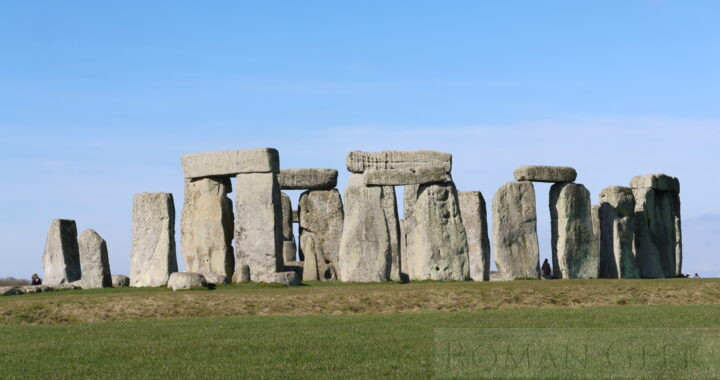- Stonehenge is a Henge Monument in Wiltshire, constructed between 2,600 and 2,300 BCE and located 8 miles (12km) north of Salisbury.
- It is a Scheduled Ancient Monument managed by English Heritage and was listed in 1986 as a Unesco World Heritage Site along with nearby Avebury.
The Site
- Excavations have shown that there has been activity at Stonehenge since at least 7,000 BCE.
- It consists of a ring of Standing Stones built during the Bronze Age between 2,600 and 2,300 BCE, with the entrance aligned to the Winter Solstice.
- A circular Ditch and Bank were constructed earlier around 3,000 BCE.
- The Cursus is the earliest Monument, and was built around 3,500 BCE. This cleared area is 1.9 miles (3km) long, and between 330 ft (100m) to 490 ft (150m) wide. Because it looks like a racing track, early historians believed it was built by the Romans. The Cursus is aligned east west with the Equinoctial Sunrise.
- A Heelstone was erected outside the circle, in alignment with the Entrance which points towards the Winter Solstice.
The BlueStones
- Originally, between 2,600-2,300 BCE Stonehenge consisted of an estimated 80 ‘Bluestones’ weighing between 2 to 4 tons each, and arranged in a double circle.
- These ‘Bluestones’ were brought from 150 miles away, quarried from Carn Menyn, a mountain peak in the Preseli Hills, Pembrokeshire, Wales. This same ‘Bluestone’ was used to make the Preseli Bluestone Axes and other Tools, some made in Preseli, others made at Stonehenge, and distributed all over Britain.
The Sarsen Stones
- After 200 years the ‘Bluestones’ were removed, and 30 Giant Sarsen stones weighing around 25 tons each were arranged in a Circle. They were given Mortice and Tenon joints to fix the Lintels on top, and were dressed to be wider at the base whilst narrowing to the top. They were collected or quarried from the Marlborough Downs 25 miles (40km) away. The 30 Lintel Stones were then placed on top of the Sarsens. The Lintels are all worked to be slightly curved in order to form a circle.
The Trilithons
- Inside the Ring of Sarsens, 5 huge pairs of Trilithon Sarsen stones were erected, weighing around 50 tons each, and creating a horseshoe shape facing the Entrance. Each pair had a lintel on top.
- Then the ‘Bluestones’ were reinstalled, forming a ring between the inner Trilithons and the outer Sarsen circle. Later still, an oval of ‘Bluestones’ was erected inside the Trilithon horseshoe shape. Today there are only 43 ‘Bluestones’ remaining at the centre of Stonehenge.
The Aubrey Holes
- There is also a ring of 56 chalk pits at Stonehenge, named the ‘Aubrey holes’, after the seventeenth-century antiquarian John Aubrey. Their role is undetermined.
Similar Monuments
- A very similar group of Bronze Age Monuments called the ‘Stonehenge of the North’ and known as the Thornborough Henges exists near York.
Possible uses:
- Astronomical Observatory
- Stonehenge may have been an astronomical observatory. The entrance is aligned with the Winter Solstice, like all the other Bronze Age Monuments.
- It has been proved that the Site could have been used to calculate the eclipses of the Sun and Moon.
- Cemetery
- Stonehenge appears to have also been a giant cemetery, and is closely surrounded by hundreds of ‘Barrows’, or Burial Mounds.
- Healing Centre
- Stonehenge may also have been a Healing Centre. The Bluestones are thought to have had special healing powers. Flakes of bluestone surround the remaining stones, indicating that they were chipped away at, and it is thought that the flakes were taken away by visitors in order to continue the healing at home.
- Religious Centre
- Stonehenge may have been a Religious centre. At the same time as the Sarsen Stones were erected, a Wooden Henge was created 2 miles away at Durrington Walls, and from evidence of giant bonfires between the two circles, it is possible that Processions walked from one to the other during both the Solstices.
- ‘Stonehenge Decoded’ (1966) by Gerald Hawkins
- An American Astronomer, Hawkins studied the stones in great detail, and discovered that the lunar eclipses could be predicted through a system of moving stones around the circle of 56 ‘Aubrey Holes’.
- He suggested Stonehenge was a giant astronomical computer.
Earliest written Record
- Hecataeus of Abdera
- Writing in the 4th century BCE, described Hyperborea as an island in the Ocean, no smaller than Sicily, and beyond the land of the Celts, which had a circular Temple, possibly meaning Stonehenge or Avebury.
- However, Hyperborea has not been identified.
- No further mention
- We know nothing of the culture that built Stonehenge, nor the reason it was built, as its builders left no written records.
- The first main Sources describing Britannia are Tacitus and Julius Caesar, but neither refer to Stonehenge nor to the other Henge Monuments.
Nearby Group of Monuments
- Stonehenge is part of a group of Bronze Age Monuments, including Avebury and Silbury Hill to the North, and Woodhenge and Old Sarum to the East.
- There are also hundreds of Barrows or Burial Mounds close by in the area.
Related Monuments
Stonehenge Public Car Park, Wiltshire

